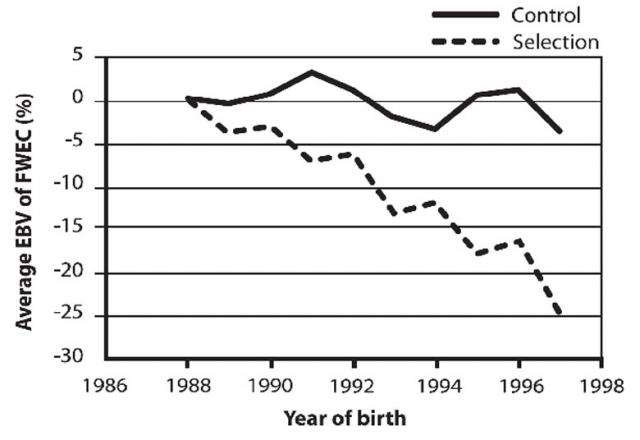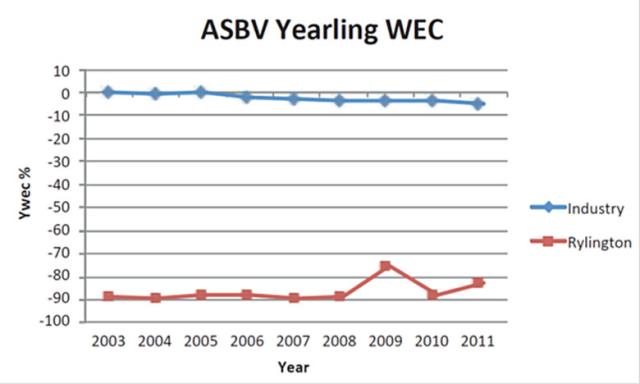Introduction
Following experience with previous drenches, it is essential that sustainable drenching practices are followed. Continuing over-reliance on chemical products will eventually result in less effective worm control, leading to losses in liveweight gain and wool production, and even mortalities in some circumstances. In economic terms the cost can be several dollars per head. To extend the remaining life of currently effective drenches, it is important to include non-chemical control options as part of the overall sheep worm control program. As with all other pest control programs, the industry needs to adopt ‘Integrated Parasite Management’ (IPM) procedures. Genetic improvement of the host’s resistance is an important component of IPM.
Worm resistant sheep
The only permanent long-term solution to help manage drench resistant worms is to breed sheep that are resistant to worms. In terms of whole farm management, resistant sheep have several advantages:
- robust and easy care sheep
- lower production losses due to worms:
- less drenching
- less labour
- lower worm contamination of paddocks
- smaller carry-over of worms from one season to the next
- less reliance on artificial control options:
- reduced impact of drench resistance
- increased life span of current effective drenches
- off-farm benefits:
- clean and green marketing potential
- sustainable production systems.
Increased worm resistance in breeding programs involves measuring the faecal worm egg counts (WEC) of individual sheep and taking that into consideration with the other production traits in making selection decisions. Some breeders are concerned that they will reduce the potential genetic gain for other production traits if they include another trait such as worm resistance in their breeding programs. Modelling studies show that including worm resistance in the breeding program results in larger gains in growth and production than selecting on production traits alone. Research results from the Mount Barker Research Station (WA) and New Zealand have confirmed huge beneficial carry-over effects for lowered faecal worm egg counts. This is mainly due to the protection that worm resistant individuals convey to their contemporaries in the mob. Thus, worm resistance should be seen as an extremely important trait in any sheep breeding program where worms could be a problem.
Resistance to worms in sheep is an inherited trait that can be increased by selection. The heritability of worm resistance, as measured indirectly by individual sheep faecal WEC, is at least 25%. This means that 25% of the phenotypic superiority of an animal will be passed on to their progeny. For example, if the average faecal WEC of a flock is 400 eggs per gram (epg) and an individual ram has a true faecal WEC of 200, then the ram's superiority is 200 epg (400 minus 200) as they are 200 epg below the flock average. With this example, 25 per cent of the superiority will be passed on to its progeny. Thus, if such animals are mated with each other, then it can be expected that their progeny will have a superiority of 50 epg (25% of 200) below the average, that is 350 epg.
There is typically a large variation in the faecal WEC between sheep, making it relatively easy to identify the more resistant individuals within a group provided the average WEC is high enough with as few animals as possible with zero WEC.
As with all genetic improvement programs, selecting within a flock can take several years to achieve noticeable improvements, but an increasing number of farmers who have been selecting sheep for worm resistance for some time have achieved very good results. Results from Sheep Genetics show that an increasing number of farmers have sheep that are relatively resistant to worms.
Research results
Since 1988 the Department of Agriculture and Food, Western Australia (DAFWA), with industry support, has been selecting for worm resistance in the Rylington Merino (RM) flock. Figure 1 shows the genetic trend of the decline of the faecal WEC in the Rylington Merino selection line relative to that of the unselected control line.

Figure 1 represents a genetic gain of 2.7% per year or about 10% per generation for selecting solely for low hogget WEC in the selected line until the year 2000. This is very good considering that the annual genetic gain for most production traits in sheep is less than 1%. During the main winter worm challenge period, the actual average faecal WEC output from hoggets in the two lines will vary from year to year due to environmental effects and inaccuracies in estimating the breeding values of animals.
Figure 2 shows the genetic merit of the selected line in the worm resistant Rylington Merino flock compared to industry flocks in Sheep Genetics' database. In this case the Rylington flock is compared to the industry average. On that graph the Australian Sheep Breeding Values (ASBV) for WEC of 0% is taken to represent an actual flock average WEC of 500 epg, and the minus 100 ASBV WEC is taken to be an animal that is totally resistant to worm with a WEC of zero epg. It is clear that the Rylington Merino flock is a highly worm resistant flock. The increase in the 2009 yearling worm egg count (YWEC) was due to the use of outside sires with less favourable ASBV for WEC. This then flows through to their progeny sires two years later.

